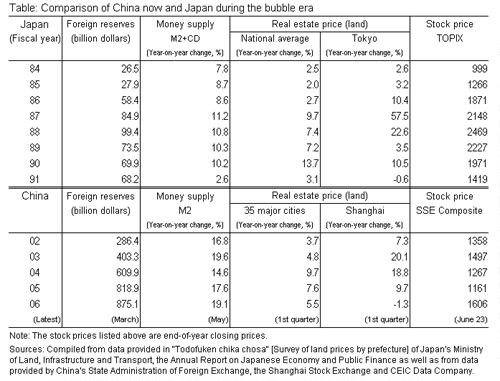In China, an asset bubble is expanding. The real estate boom since 2002 has been followed by a rally in stock prices over the last twelve months. The biggest factor behind this is the excess liquidity resulting from the monetary authorities' massive interventions in the foreign exchange market amid the increasing upward pressure on the yuan. The situation is coming to increasingly resemble that of Japan in the late 1980s (table 1). Unfortunately, however, the Chinese authorities have been so concerned about the deflationary pressure due to the rise of its currency as Japan experienced in the past (McKinnon's hypothesis) that they have overlooked the causality between the monetary easing adopted to prevent excessive appreciation of the yen and the expansion of the asset bubble (Kuroda's hypothesis). Thus lessons from Japan's experience, which should serve China well, have not been properly learned.
In China, the mainstream view on Japan's experience with the sharp rise of the yen is that the long-term upward trend of the yen has been exerting strong deflationary pressure on the Japanese economy, as argued by Professor Ronald McKinnon of Stanford University.(note 1) With the yen rising at an annual rate of 4% since the 1970s and expectations of an ever-higher yen becoming the norm, interest rates in Japan have stayed below those in the U.S. by about the same margin (Level of Japanese interest rates = Level of U.S. interest rates - Appreciation Expectations of the yen vis-a-vis the dollar), reflecting interest-rate arbitrage. The situation was manageable while U.S. interest rates remained at a relatively high level. However, as interest rates began to fall in the 1990s, Japanese interest rates were driven lower and lower, and by the latter half of the 1990s, Japan fell into a "liquidity trap," a situation in which nominal interest rates cannot go down any further at they approached the zero level. Professor McKinnon argues that this has inhibited Japanese monetary authorities' capacity to implement effective monetary policy, thus resulting in the prolonged economic recession. He also warns that, if China yielded to US pressure, as Japan did, and to revalue the yuan and shift to a floating exchange rate system, deflation would become serious and China also might fall into a liquidity trap.(note 2)
Meanwhile, another view on Japan's experience - though this remains a minority view in China - held by Mr. Haruhiko Kuroda, former Vice Minister of Finance and President of Asian Development Bank, sees not the yen's appreciation itself but the monetary easing policy adopted as a way to alleviate deflationary pressure brought by the appreciation of the yen as the cause of the bubble economy in the latter half of the 1980s.(note 3) The dollar's exchange rate against the yen, which was at around 240 yen at the time of the Plaza Accord in September 1985, fell below the 200 yen level at the end of 1985, then to 150 yen a year later. To help the export industry that lost international competitiveness due to the yen's appreciation, the Bank of Japan (BOJ) cut the discount rate five times between January 1986 and February 1987 from 5% to 2.5%, and the rate, which was a record low at the time, was maintained until May 1989.(note 4) Meanwhile, based on the recognition that the objective of correcting the overvalued dollar had been achieved, finance ministers and central bank governors of the Group of Seven industrialized countries agreed in the Louvre Accord to seek to stabilize the U.S. dollar in February 1987. With this, the BOJ embarked on aggressive dollar-buying interventions. An increase in money supply resulting from the sharp cuts in the discount rate and massive interventions in the foreign exchange market gave rise to excess liquidity, which was channeled into stock and real estate markets. This in turn added fuel to the asset bubble and paved the way to the problems the Japanese economy faced in the 1990s.
As maintained by McKinnon's hypothesis, it is partly true that the rising yen (or expectations thereof) accelerated deflation in the post-bubble Japanese economy, but the current state of the Chinese economy more resembles that of the Japanese economy in the latter half of the 1980s as depicted in Kuroda's hypothesis. In order not to repeat Japan's bitter experience, China must waste no time and curb excess liquidity by scaling back interventions and letting the yuan to appreciate at a faster pace.



